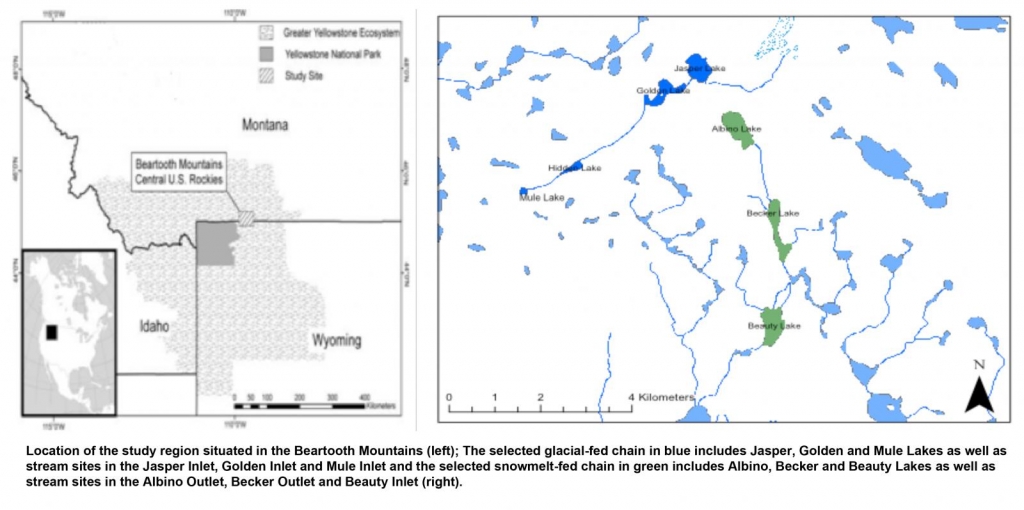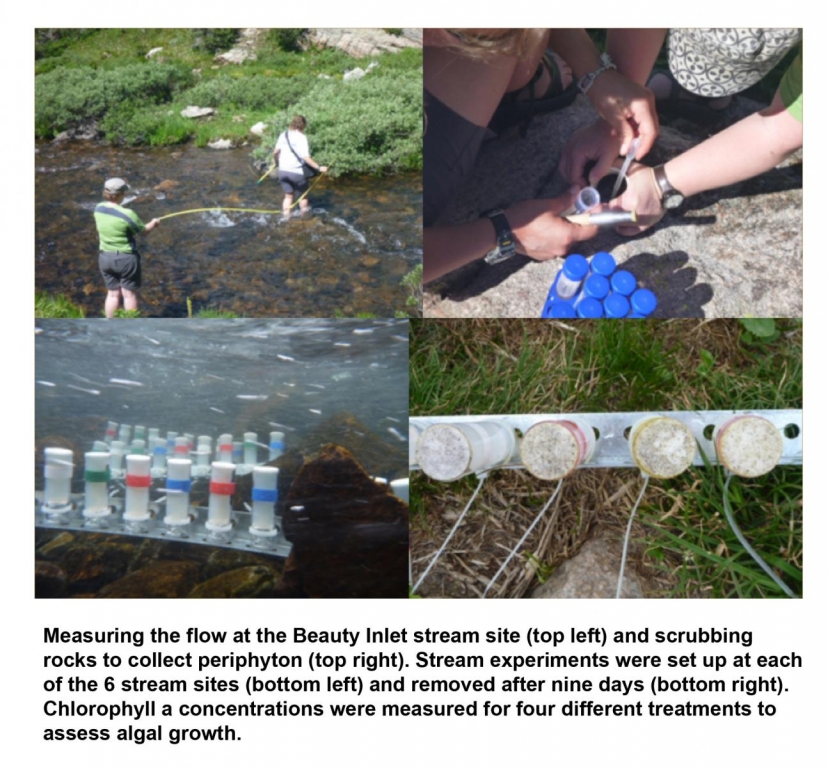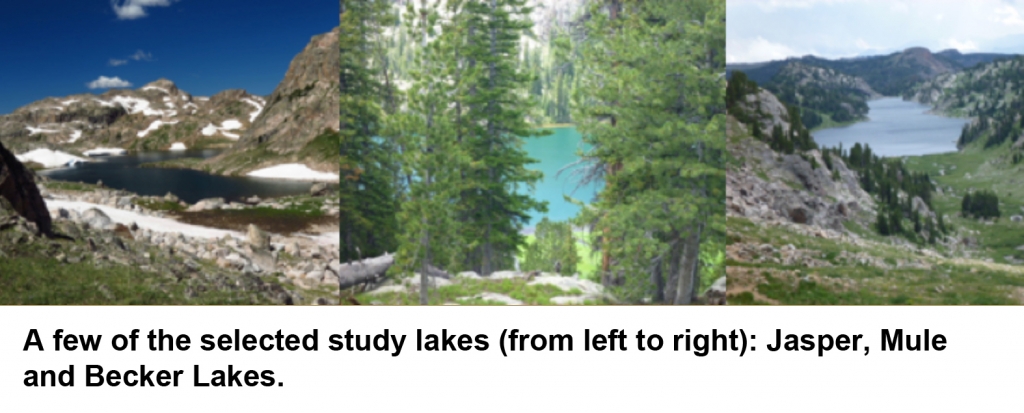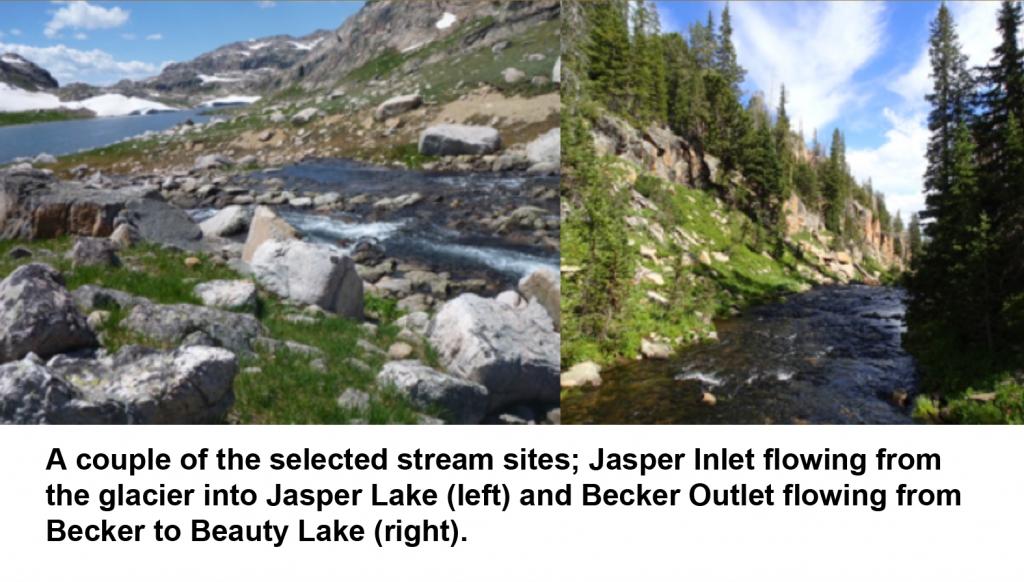Beartooth Mountains, Montana 2012
Beartooth Mountains, Montana 2012
Nitrogen Subsidies in Glacial Meltwater: Implications for High Elevation Aquatic Chains
Beartooth Mountains, Montana – 2012
Field Team Members: Kate Warner, Jasmine Saros, Carl Tuggend, Katie Norris and Jenny Shrum
Dates: July 18th – August 8th 2012
Funding for this project was generously provided by the Dan and Betty Churchill Exploration Fund and the Gokcen Fund
Alpine glaciers have receded substantially over the past century, with only 10 to 20 years of glacial coverage remaining in many regions of the central Rocky Mountains (Granshwaw & Fountain 2006; Meier et al. 2007; Cannone et al. 2008). Changes to these glaciers and the volume of glacial runoff have significant effects on nutrient chemistry in alpine lakes. Glaciers worldwide are melting rapidly causing an increase in glacial meltwater flow into lakes and streams (Granshaw & Fountain, 2006; Meier et al., 2007; Cannone et al., 2008). Recent research demonstrates that glacial meltwater is rich in reactive nitrogen (Saros et al., 2010), a biologically available form of nitrogen. Glaciers contribute to large nitrate concentrations found throughout glacial-fed aquatic systems, while nitrate concentrations remain low in snowmelt-fed systems (Saros et al. 2010). The variation in nutrient concentrations and increase in nitratein glacial-fed systems are what drive the changing patterns of nutrient limitation. Nitrogen is an important limiting nutrient in alpine lakes (Morris et al. 1988; Saros et al. 2005) and nitrogen enrichment from glacial meltwaters can strongly influence biodiversity of alpine lake ecosystems (Saros et al. 2010).
It remains unclear how these nitrogen subsidies propagate down a chain of lakes and streams. In this study, nutrient limitation experiments, enzyme analysis and an assessment of species diversity were used to assess the impacts of glacial nitrogen on a chain of lakes and streams fed by glacial meltwater and an aquatic chain fed by snowmelt alone. Analyzing nutrient limitation, algal biomass and algal diversity in not a single lake or stream, but throughout a series of lakes and steams, will allow for better understanding of how changes due to glacial meltwater may or may not propagate down the chain. The objective of this study was to assess the effects of these nutrient subsidies in a set of aquatic chains in the U.S. central Rocky Mountains and more specifically to pair an understanding of how increased nitrogen can change the limiting nutrients, algal biomass and biodiversity of aquatic ecosystems with an understanding of the influence that lakes, streams and the landscape have on each other. As glaciers disappear it is important to understand how the loss of this resource subsidy will affect aquatic chains.
References:
Cannone N., Diolaiuti G., Guglielmin M., Smiraglia C. 2008. Accelerating climate change impacts on alpine glacier forefield ecosystems in European Alps. Ecological Applications. 18: 637-648.
Granshwaw F.D., Fountain A.C. 2006. Glacier change (1958-1998) in Northern Cascades National Park Complex, Washington, USA. Journal of Glaciology. 52: 251-256.
Meier M.F., Dyurgerov M.B., Rick, U.K. et al., 2007. Glaciers dominate eustatic sea-level rise in the 21st century. Science. 317: 1064-1067.
Morris D.P., Lewis W.M., Jr. 1988. Phytoplankton nutrient limitation in Colorado mountain lakes. Freshwater Biol. 20: 315-327.
Saros J.E., Michel T.J., Interlandi S.J., Wolfe A.P. 2005. Resource requirements of Asterionella Formosa and Fragilaria crotonensis in oligotrophic alpine lakes: implications for recent phytoplankton community reorganizations. Can. J. Fish. Aquat. Sci. 62: 1681-1689.
Saros J.E., Rose K.C., Clow D.W., Stephens V.C., Nurse A.B., Arnett H.A., Stone J.R., Williamson C.E., Wolfe A.P. 2010. Melting Alpine Glaciers enrich high elevation lakes with reactive nitrogen. Environ. Sci. Technol. 44: 4891-4896.







